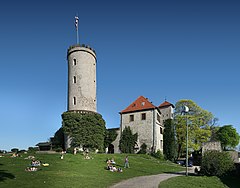Sparrenberg Castle
| Sparrenberg Castle | |
|---|---|

Donjon – tower of the Sparrenburg
|
|
| General information | |
| Town or city | Bielefeld |
| Country | Germany |
| Coordinates | 52°00′54″N 8°31′36″E / 52.0149°N 8.52678°E |
| Completed | < 1260 |
| Client | Counts of Ravensberg |
Sparrenberg Castle, also known as the Sparrenburg (German: Burg und Festung Sparrenberg or Sparrenburg), is a restored fortress in the Bielefeld-Mitte district of Bielefeld, Germany. It is situated on the Sparrenberg hill (180 metres (590 ft) altitude) in the Teutoburg Forest and towers 60 metres (200 ft) above the city centre. Its current appearance mainly originated in the 16th and 19th century. The Sparrenburg is considered to be Bielefeld's landmark.
The Sparrenburg was erected as a castle sometime before 1250 by the counts of Ravensberg. It guarded the Bielefeld Pass over the Teutoburg Forest, as well as acting as the ruling seat of the counts of Ravensberg, and as protection for the city of Bielefeld, probably founded around 1200. Because the construction of a protective castle generally predates the foundation of a town, it is assumed that there was an older castle. In 1256, the castle was first mentioned in records.
In 1346, Bernard, Count of Ravensberg died without issue and, with his death, the line of Calvelage-Ravensberg was extinguished. The castle was transferred through marriage to Count Gerhard I of Jülich-Berg, who had been married to Bernard's niece Margaret since 1338, and its function as the ruling seat was lost. On 18 November 1377, Emperor Charles IV stayed overnight at the castle. From 1410 to 1428 the Sparrenburg served as a ruling seat for a last time, for Count William II of Ravensberg, who came from the line of the House of Jülich that ruled the Duchy of Berg. In 1511, the Sparrenburg changed hands again. William IV, Duke of Jülich-Berg, who was also the count of Ravensberg, died and County and castle were handed over to his son-in-law John III, Duke of Cleves.
...
Wikipedia
